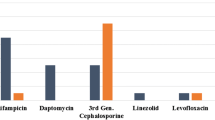Abstract
Background
The incidence of methicillin-resistant Staphylococcus aureus (MRSA) infection is increasing. However, the prevalence of MRSA colonization among patients undergoing spine surgery is unclear.
Questions/purposes
We therefore (1) determined the prevalence of MRSA colonization in a population of patients scheduled for elective spine surgery; and (2) evaluated whether MRSA screening and treatment reduce the rate of early wound complications.
Methods
We retrospectively reviewed prospectively collected data from 1002 patients undergoing elective spine surgery in 2010. There were 719 primary and 283 revision surgeries. Instrumentation was used in 72.0% cases and autologous iliac crest bone graft was taken in 65.1%. Twelve patients were lost to followup; of the remaining 990 patients, 503 were screened for MRSA and 487 were not. MRSA-colonized patients were treated with mupirocin and chlorhexidine. An early wound complication was defined as wound drainage or the presence of an abscess. Patients were followed for a minimum of 3 months (average, 7 months; range, 3–545 days).
Results
Of the patients undergoing elective spine surgery and screened for MRSA, 14 of 503 (2.8%) were colonized with MRSA. The rates of early wound complications were similar for patients who were screened and pretreated for MRSA (17 of 503 [3.4%]) compared with those who were not (17 of 487 [3.5%]).
Conclusions
The colonization rate for MRSA in our elective spine surgery population was comparable to that in the arthroplasty literature.
Level of Evidence
Level III, retrospective comparative study. See the Guidelines for Authors for a complete description of levels of evidence.


Similar content being viewed by others

References
Blom AW, Brown J, Taylor AH, Pattison G, Whitehouse S, Bannister GC. Infection after total knee arthroplasty. J Bone Joint Surg Br. 2004;86:688–691.
Committee on Comparative Effectiveness Research Prioritization, Institute of Medicine. Initial National Priorities for Comparative Effectiveness Research. Washington, DC, USA: The National Academies Press; 2009.
Dindo D, Demartines N, Clavien PA. Classification of surgical complications: a new proposal with evaluation in a cohort of 6336 patients and results of a survey. Ann Surg. 2004;240:205–213.
Epstein NE. Preoperative, intraoperative, and postoperative measures to further reduce spinal infections. Surg Neurol Int. 2011;2:17.
Kalmeijer MD, Coertjens H, van Nieuwland-Bollen PM, Bogaers-Hofman D, de Baere GA, Stuurman A, van Belkum A, Kluytmans JA. Surgical site infections in orthopedic surgery: the effect of mupirocin nasal ointment in a double-blind, randomized, placebo-controlled study. Clin Infect Dis. 2002;35:353–358.
Kang BU, Lee SH, Ahn Y, Choi WC, Choi YG. Surgical site infection in spinal surgery: detection and management based on serial C-reactive protein measurements. J Neurosurg Spine. 2010;13:158–164.
Kluytmans J, van Belkum A, Verbrugh H. Nasal carriage of Staphylococcus aureus: epidemiology, underlying mechanisms, and associated risks. Clin Microbiol Rev. 1997;10:505–520.
Lindeque B, Rutigliano J, Williams A, McConnell J. Prevalence of methicillin-resistant Staphylococcus aureus among orthopedic patients at a large academic hospital. Orthopedics. 2008;31:363.
Nagashima H, Yamane K, Nishi T, Nanjo Y, Teshima R. Recent trends in spinal infections: retrospective analysis of patients treated during the past 50 years. Int Orthop. 2010;34:395–399.
Peersman G, Laskin R, Davis J, Peterson M. Infection in total knee replacement: a retrospective review of 6489 total knee replacements. Clin Orthop Relat Res. 2001;392:15–23.
Perl TM, Golub JE. New approaches to reduce Staphylococcus aureus nosocomial infection rates: treating S aureus nasal carriage. Ann Pharmacother. 1998;32:S7.
Rao N, Cannella B, Crossett LS, Yates AJ Jr, McGough R 3rd. A preoperative decolonization protocol for Staphylococcus aureus prevents orthopaedic infections. Clin Orthop Relat Res. 2008;466:1343–1348.
Schuster JM, Rechtine G, Norvell DC, Dettori JR. The influence of perioperative risk factors and therapeutic interventions on infection rates after spine surgery: a systematic review. Spine (Phila Pa 1976). 2010;35(Suppl):S125–S137.
Sink EL, Beaulé PE, Sucato D, Kim Y, Millis MB, Dayton M, Trousdale RT, Sierra RJ, Zaltz I, Schoenecker P, Monreal A, Clohisy J. Multicenter study of complications following surgical dislocation of the hip. J Bone Joint Surg Am. 2011;93:1132–1136.
Slover J, Haas JP, Quirno M, Phillips MS, Bosco JA 3rd. Cost-effectiveness of a Staphylococcus aureus screening and decolonization program for high-risk orthopedic patients. J Arthroplasty. 2011;26:360–365.
Urban JA. Cost analysis of surgical site infections. Surg Infect (Larchmt). 2006;7(Suppl 1):S19–S22.
Viola RW, King HA, Adler SM, Wilson CB. Delayed infection after elective spinal instrumentation and fusion. A retrospective analysis of eight cases. Spine (Phila Pa 1976). 1997;22:2444–2450.
Weinstein MA, McCabe JP, Cammisa FP Jr. Postoperative spinal wound infection: a review of 2391 consecutive index procedures. J Spinal Disord. 2000;13:422–426.
Wenzel RP, Perl TM. The significance of nasal carriage of Staphylococcus aureus and the incidence of postoperative wound infection. J Hosp Infect. 1995;31:13.
Zimmerli W, Trampuz A, Ochsner PE. Prosthetic-joint infections. N Engl J Med. 2004;351:1645–1654.
Acknowledgments
We thank Dr Nalini Rao for her infectious disease expertise and assistance with the MRSA/MSSA screening and decolonization program at our institution.
Author information
Authors and Affiliations
Corresponding author
Additional information
Each author certifies that he or she has no commercial associations (eg, consultancies, stock ownership, equity interest, patent/licensing arrangements, etc) that might pose a conflict of interest in connection with the submitted article.
All ICMJE Conflict of Interest Forms for authors and Clinical Orthopaedics and Related Research editors and board members are on file with the publication and can be viewed on request.
Each author certifies that his or her institution approved the human protocol for this investigation and that all investigations were conducted in conformity with ethical principles of research.
This work was performed at the University of Pittsburgh Medical Center, Pittsburgh, PA, USA.
About this article
Cite this article
Chen, A.F., Chivukula, S., Jacobs, L.J. et al. What Is the Prevalence of MRSA Colonization in Elective Spine Cases?. Clin Orthop Relat Res 470, 2684–2689 (2012). https://doi.org/10.1007/s11999-012-2316-5
Published:
Issue Date:
DOI: https://doi.org/10.1007/s11999-012-2316-5



